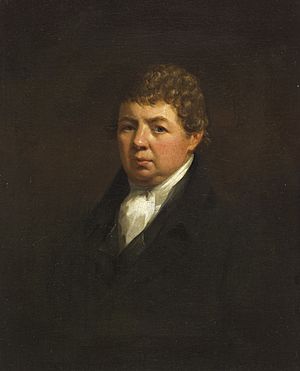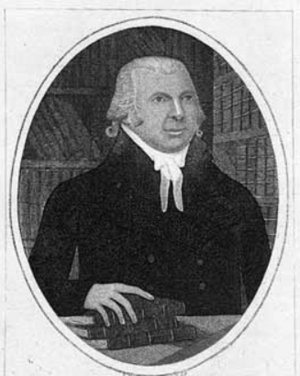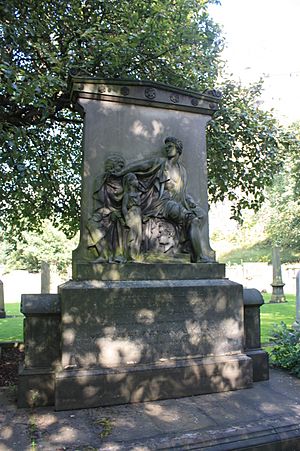John Jamieson facts for kids
Quick facts for kids
John Jamieson
FRSE FSA Scot FRSL
|
|
|---|---|

John Jamieson by William Yellowlees
|
|
| Born | 3 March 1759 Glasgow
|
| Died | 12 July 1838 (aged 79) |
| Resting place | St. Cuthbert's Cemetery, Edinburgh |
| Nationality | Scottish |
| Citizenship | Great Britain |
| Education | Glasgow Grammar School |
| Alma mater | Glasgow University (1768-71) Edinburgh University (1775-6) College of New Jersey (DD 1795) |
| Occupation | Licensed minister (1781) Minister of secessionist congregation Forfar, Angus Minister of the Nicolson Street Antiburgher Church, Edinburgh (1797–1830) |
|
Notable work
|
"Etymological Dictionary of The Scottish Language" (1808) "History of the Culdees" (1811) "Views of the Royal Palaces of Scotland" (1828) |
| Spouse(s) | Charlotte Watson (died 1837) |
| Notes | |
|
Fellow of the Royal Society of Edinburgh (1803)
Fellow of the Society of Antiquaries of Scotland (1815) Fellow of the American Antiquarian Society Fellow of the Royal Literary Society Member of the Highland Society |
|
John Jamieson (born March 3, 1759 – died July 12, 1838) was a Scottish minister, a person who studied languages, and someone who loved old things. He is best known for creating a very important dictionary called the Etymological Dictionary of the Scottish Language. This book helped people understand the history of Scottish words.
Life Story
John Jamieson was born in Glasgow, Scotland, in March 1759. His father was also a minister named John Jamieson. John went to Glasgow Grammar School for his early education.
He then studied at the University of Glasgow from 1768 to 1771. Later, he took classes to become a minister at the University of Edinburgh from 1775 to 1776. After six years of studying religion, Jamieson was allowed to preach in 1781. He became the minister for a church group called the Secessionists in Forfar, Angus. He was 23 years old when he became a minister.
In 1788, he was asked to lead the Anti-burgher church in Nicolson Street, Edinburgh. He didn't accept right away, but he did become their minister in 1797. John Jamieson played a big part in bringing together two church groups, the Burgher and Anti-Burgher "New Licht" churches. They formed the United Secession Church in 1820.
He stopped working as a minister in 1830. He spent the rest of his life in Edinburgh. In the 1830s, he lived at 4 George Square in the southern part of the city.
Jamieson was chosen as a member of the Royal Society of Edinburgh in 1803. This is a group for important thinkers and scientists. He was also a member of the Society of Antiquaries of Scotland, which studies old things and history. In 1816, he became a member of the American Antiquarian Society.
He retired in 1830 because he was not well. John Jamieson died at his home in George Square, Edinburgh on July 12, 1838. He is buried in St Cuthbert's churchyard in Edinburgh. His grave is large and special, shared with his son Robert who passed away before him.
His Books and Writings
Jamieson's most important book was the Etymological Dictionary of the Scottish Language. It came out in two volumes in 1808. A Danish scholar named Grim Thorkelin gave him the idea for this dictionary. Jamieson worked almost by himself to complete this huge project.
He made a shorter version of the dictionary in 1818. With help from many others, he added two more volumes in 1825. This dictionary included old stories and local words from different parts of Scotland. It also discussed how the ancient Pictish language might have influenced the Scots language.
This dictionary was the main reference for the Scots language for many years. It was used until the Scottish National Dictionary was published in 1931.
Jamieson wrote many other books and papers, including:
- Socinianism Unmasked, published in 1786.
- The Sorrows of Slavery, a paper from 1789 about the African slave trade.
- Sermons on the Heart, a two-volume set from 1791.
- Congal and Fenella, a Metrical Tale, a story told in poetry from 1791.
- Vindication of the Doctrine of Scripture, a book from 1795.
- A Poem on Eternity, a poem from 1798.
- The Use of Sacred History, published in 1802.
- A Treatise on the Ancient Culdees of Iona (also called A History of the Culdees), published in 1811.
- Hermes Scythicus, from 1814, which explored connections between old languages.
- Supplement to the Etymological Dictionary of the Scottish Language, two more volumes from 1825.
- Views of the Royal Palaces of Scotland, published in 1828.
He also wrote about other topics like public speaking, cremation, and the royal palaces of Scotland. In 1820, he edited older versions of famous Scottish poems like Bruce by John Barbour and Wallace by Blind Harry.
Family Life
In 1781, John Jamieson married Charlotte Watson, who passed away in 1837. They had seventeen children together, but sadly, only two daughters and one son lived to adulthood. His son, Robert Jameson, became a lawyer. His daughter Margaret Robina married Donald Mackenzie.



